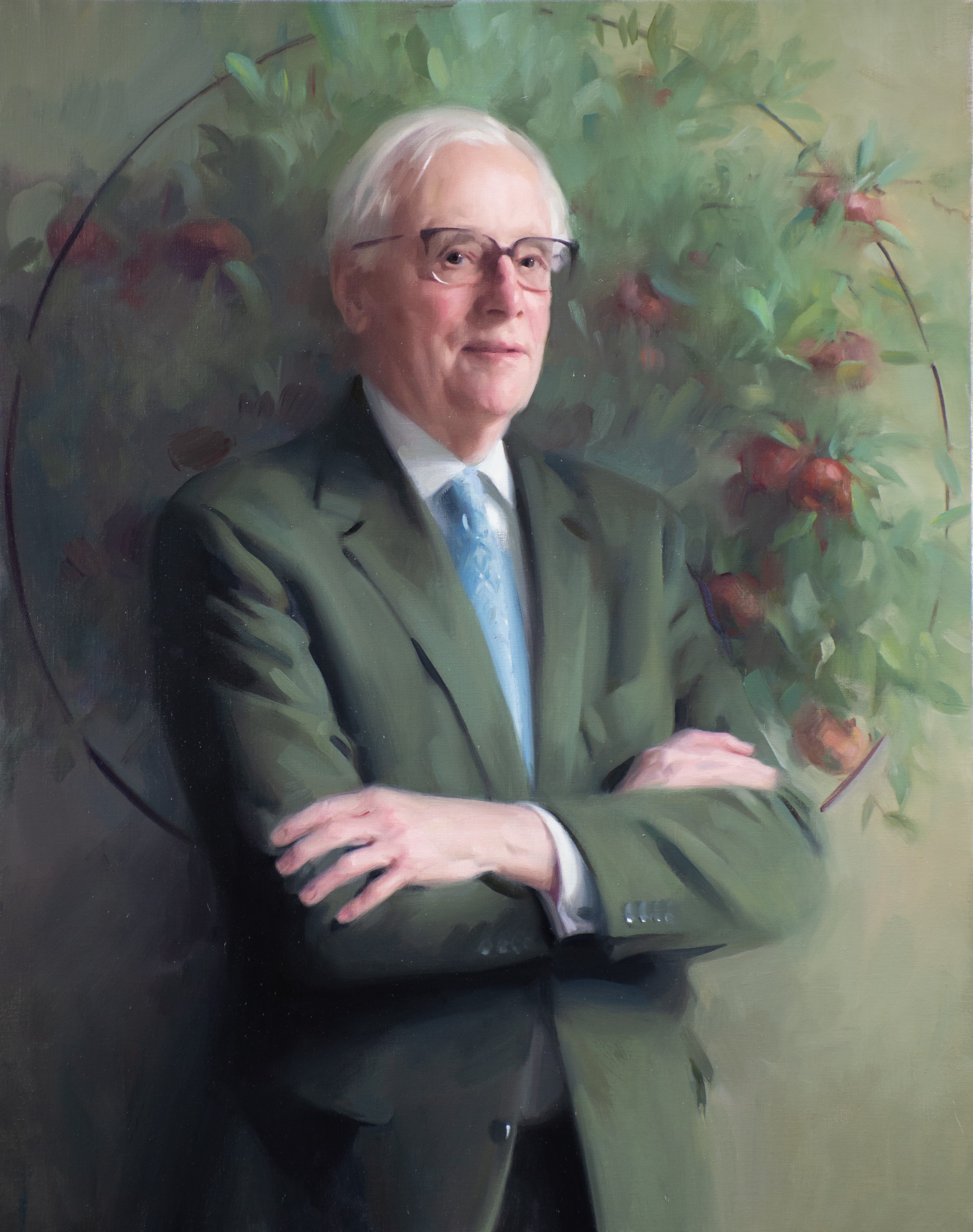The new portrait, by Frances Bell RP ROI, was unveiled on 4 October and features Sir John framed by a ring of apples.
Professor Sir John Walker, by Frances Bell RP ROI.
The idea for the apples came after Sir John shared with Frances his story of how he learned he had become a Nobel Laureate: ‘In the weeks leading up to the announcement of the 1997 Nobel Prizes, I received several e-mails and phone calls from colleagues and former associates saying that I would be awarded the Prize In Chemistry that year, but I refused to engage with the notion.
‘On the day of the announcement, to avoid any possibility of my being subject to further speculation prior to the announcement itself, I left the laboratory in the late morning and went home to work in my garden, where I set about pruning an apple tree.
'Whilst absorbed in the task of removing a branch high up in the tree, I realised that the phone was ringing incessantly in the house, so I climbed down and on lifting the receiver I was greeted by a journalist at a radio station in Cologne who asked: “How does it feel to win the Nobel Prize, Herr Walker?”
‘“I don’t have the first idea,” I responded.
‘I was sceptical, and so I contacted some reliable sources for confirmation. Only then did I start to believe.’
Having completed his undergraduate studies and DPhil at the University of Oxford in the 1960s, and held research positions at the University of Wisconsin and The Pasteur Institute, the then Dr John Walker joined The Medical Research Council (MRC) Laboratory of Molecular Biology at Cambridge in 1974.
Already an expert in the analysis of proteins, at the MRC Lab he developed his interest in the mitochondria - small organs within cells that, amongst other things, break down food molecules, creating energy. He began working on the structure of the gigantic enzyme adenosine triphosphate synthase which, through a process of oxidation, generates adenosine triphosphate, or ATP, the main energy molecule in mammalian cells. By 1992, he had realised that ATP synthase is a molecular machine: the energy released from food drives the production of ATP by a mechanical rotary mechanism.
‘For me, the ring of apples has additional significance. The Prize was awarded for my efforts in unravelling details of an extraordinarily complicated enzyme called ATP synthase. It is, as I proposed, a molecular machine that works with a rotary action to make the 50 kg (yes, 50 kilograms) of ATP that each of us makes every day to provide energy in a suitable form to sustain all of our bodily activities. The turning of the enzyme’s rotor, at speeds of up to 200 times per second, is driven by energy derived from carbohydrates, fats and proteins in the food we consume.
‘At the time, in 1997, I did not understand the precise molecular basis of how this rotation was being generated, although I knew that a ring of proteins in the machine’s rotor was involved, and so at the end of my Nobel Lecture I quoted two lines from a poem by Robert Frost: “We dance round in a ring and suppose, But the Secret sits in the middle and knows”.
‘My colleagues and I finally unravelled the full secret - the rotary action of ATP synthase - in 2020.’
Frances Bell takes up the story: ‘I wanted to include a reference to John’s work within the painting, but with John’s large scale model (of the ATP synthase molecule) being too big and bulky for my canvas dimensions to display literally, I set off into the neighbourhood of symbolism. John uses images like “lollipop” and “pruned trees” to describe the shape of the molecule to laymen, but when he told me during sittings that he spent the day of the Nobel announcement in his garden, pruning his apple trees, my narrative appeared.
'I loved the idea of John literally disappearing into one of the symbols of his discovery, almost as refuge, as the Nobel committee rang and rang in vain.’
Before Sir John and Frances officially unveiled the portrait in Hall, Professor Richard Penty, Sidney's 27th Master, paid tribute to John's contribution to the College's Research Fellowship Competition, which brings early career researchers into the Fellowship, and to the Nobel Laureate’s modesty. The audience of Fellows and invited guests included former PhD students of John's.
Sir John said he felt ‘greatly honoured’ to have his portrait in College Hall, and ‘very happy’ with the finished painting: ‘My family and friends have told me that they think that it is an excellent likeness. I am really pleased to have had the good fortune to have had my portrait painted by Frances Bell.’
If you have something that would make a good news or feature item, please email news@sid.cam.ac.uk

